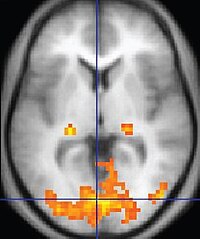
Photo from wikipedia
Previous studies suggest there is a complex relationship between sexual and general affective stimulus processing, which varies across individuals and situations. We examined whether sexual and general affective processing can… Click to show full abstract
Previous studies suggest there is a complex relationship between sexual and general affective stimulus processing, which varies across individuals and situations. We examined whether sexual and general affective processing can be distinguished at the brain level. In addition, we explored to what degree possible distinctions are generalizable across individuals and different types of sexual stimuli, and whether they are limited to the engagement of lower-level processes, such as the detection of visual features. Data on sexual images, nonsexual positive and negative images, and neutral images from Wehrum et al. (2013) (N = 100) were reanalyzed using multivariate support vector machine models to create the brain activation-based sexual image classifier (BASIC) model. This model was tested for sensitivity, specificity, and generalizability in cross-validation (N = 100) and an independent test cohort (N = 18; Kragel et al. 2019). The BASIC model showed highly accurate performance (94-100%) in classifying sexual versus neutral or nonsexual affective images in both datasets with forced choice tests. Virtual lesions and tests of individual large-scale networks (e.g., visual or attention networks) show that individual networks are neither necessary nor sufficient to classify sexual versus nonsexual stimulus processing. Thus, responses to sexual images are distributed across brain systems.
Journal Title: Cerebral cortex
Year Published: 2021
Link to full text (if available)
Share on Social Media: Sign Up to like & get
recommendations!